Welcome to the future of home entertainment! Are you tired of experiencing lackluster sound quality while watching movies on your projector? Say goodbye to those days of straining to hear dialogue and missing out on the immersive experience. This blog post will discuss a game-changing solution to take your home theater to the next level: connecting a Vizio Soundbar to a projector. Say hello to crystal-clear audio that will transport you into a world of cinematic magic. So grab your popcorn and get ready to transform your movie nights into a breathtaking audiovisual adventure. Connecting a Vizio Soundbar to a projector has never been easier, and this article is here to guide you through it step by step. Say goodbye to mediocre sound and welcome the ultimate home theater experience!
What is a soundbar?
A soundbar, also known as a sound projector, is a type of loudspeaker that is specifically designed to be placed under or above a television set. Its main purpose is to provide an immersive and high-quality audio experience while watching movies, TV shows, or listening to music. The soundbar is an all-in-one audio system that combines multiple speakers into a single unit, eliminating the need for separate speakers and complicated wiring setups.
Soundbars come in various shapes, sizes, and styles to cater to different preferences and room setups. Some soundbars feature a sleek and slim design, seamlessly blending with the aesthetics of modern TV sets. Others may come with additional features such as built-in subwoofers or wireless connectivity options for a more customizable and convenient setup.
In summary, a soundbar is an essential audio companion for any TV setup, providing a convenient and space-saving solution for high-quality audio reproduction. Its versatility, sleek design, and advanced features make it a popular choice for enhancing the audio experience while watching content on a TV [1].
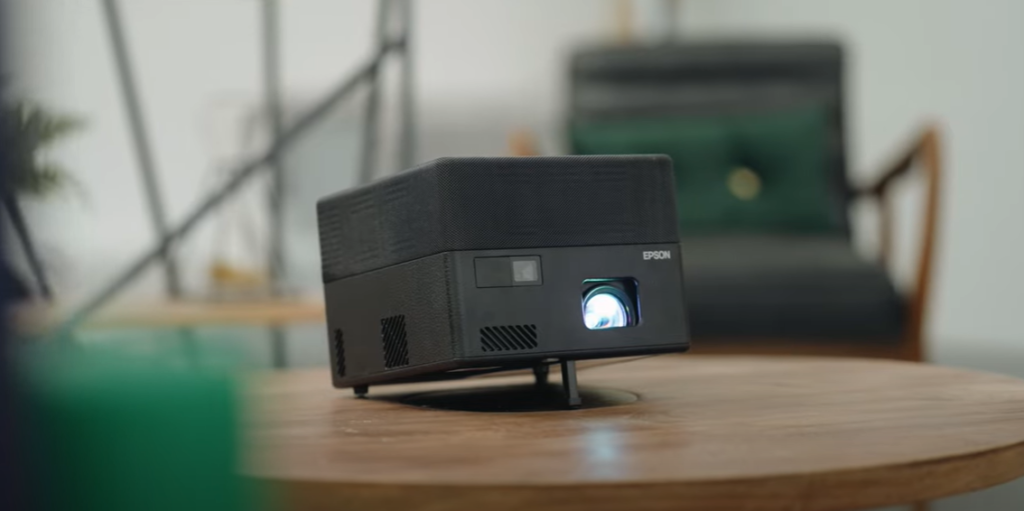
Why Should You Connect Your Soundbar to Your Projector?
There are several reasons why you should connect your soundbar to your projector. Firstly, by connecting these two devices, you can significantly enhance your audio-visual experience. Projectors usually do not have built-in speakers, so the sound quality may be subpar. By adding a soundbar, you can get high-quality audio that matches the stunning visuals from your projector.
Another reason to connect your soundbar to your projector is the convenience it offers. With just one connection, you can have both audio and video playing simultaneously. This eliminates the need for multiple cables and switches, making the setup process much simpler and hassle-free.
Moreover, connecting your soundbar to your projector allows for a more streamlined and clutter-free home theater setup. As most projectors are ceiling-mounted, it can be challenging to route audio cables without creating an unsightly mess. By connecting the soundbar directly to the projector, you can keep your room clean and organized.
In addition, many modern projectors have advanced features such as Bluetooth connectivity and voice control. By connecting your soundbar, you can take advantage of these features and have a seamless entertainment experience. You can easily connect your smartphone or other Bluetooth-enabled devices to the soundbar and play music or stream movies wirelessly.
Lastly, connecting your soundbar to your projector is a cost-effective solution. Instead of investing in a separate audio system, you can simply add a soundbar to your existing projector setup. This way, you can save money while still achieving high-quality audio.
In conclusion, connecting your soundbar to your projector has numerous benefits and is essential for a complete home theater experience. It enhances audio quality, offers convenience, reduces clutter, allows for advanced features, and saves money. So if you haven’t connected your soundbar yet, it’s time to do so and take your movie nights to the next level.
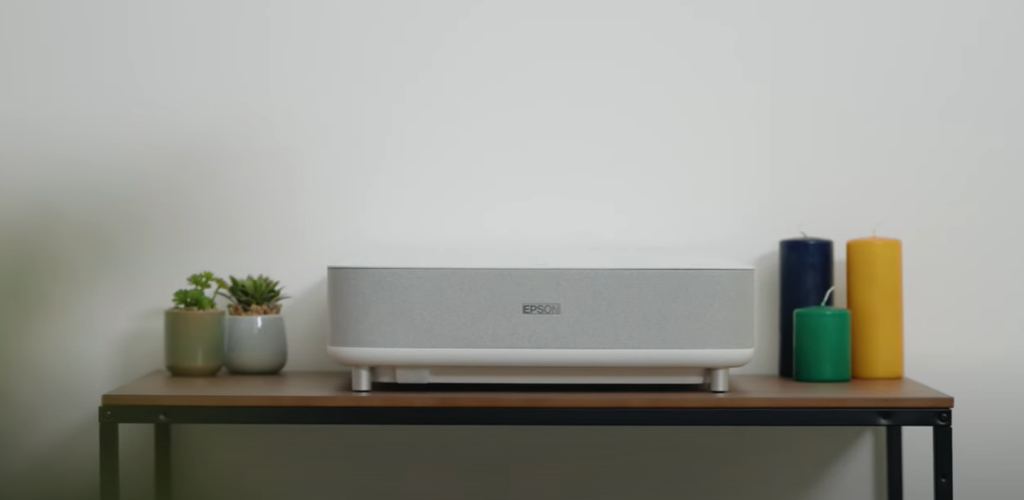
Connecting a Soundbar to a Projector via HDMI
Connecting HDMI with the Projector as the Source
The HDMI technology has revolutionized the way we connect and transmit audio and video signals between devices. It offers high-quality digital transmission, making it a popular choice for connecting soundbars to projectors. To connect your soundbar to a projector via HDMI, follow these steps:
- Check the ports: Before attempting to connect your soundbar and projector, make sure both devices have HDMI ports. Ideally, the soundbar should have at least one HDMI input and the projector should have an HDMI output.
- Prepare the HDMI cable: Get a high-speed HDMI cable that is long enough to reach from your soundbar to the projector. It’s recommended to use a cable with gold-plated connectors for better signal transmission.
- Turn off both devices: It’s important to turn off both the soundbar and projector before making any connections.
- Connect the HDMI cable: Plug one end of the HDMI cable into the HDMI output port on your projector and the other end into an available HDMI input on your soundbar. Make sure to insert the cable fully into each port.
- Set up audio output: In most cases, your soundbar will automatically switch to the HDMI input once connected. However, if it doesn’t, you may need to manually change the audio output on your projector to HDMI.
- Turn on both devices: Once the cable is securely connected and the audio output is set to HDMI, turn on both devices and test the connection.
- Adjust settings (if needed): Depending on your soundbar and projector models, you may need to adjust the audio and video settings for optimal performance.
- Enjoy your setup: Congratulations, your soundbar is now connected to your projector via HDMI! You can now enjoy high-quality audio from your projector without the need for extra speakers or complicated wiring.
Connecting HDMI with an Auxiliary Source
Another way to connect your soundbar to a projector via HDMI is by using an auxiliary source, such as a streaming device or gaming console. This method allows you to stream audio and video from multiple sources through your soundbar and project it onto the big screen.
To connect your soundbar to a projector via HDMI using an auxiliary source, first, ensure that both the source and the soundbar have HDMI ports. Connect the HDMI cable from the source to the HDMI input on the soundbar. Then, follow the same steps as mentioned above for connecting HDMI with the projector as the source.
By connecting your soundbar to the projector, you can easily switch between different devices and enjoy high-quality audio through the soundbar while using the projector for stunning visuals. This setup enhances your overall entertainment experience, immersing you in both exceptional sound and captivating visuals.
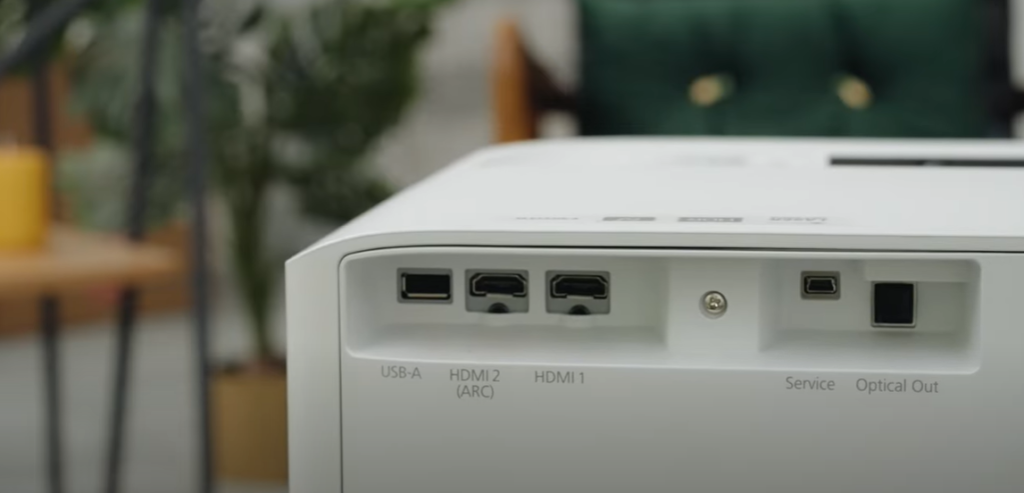
Using CEC (Consumer Electronics Control)
Some projectors and soundbars come with CEC (Consumer Electronics Control) technology, which allows devices to communicate and control each other through HDMI. This means that when you turn on your projector, it automatically turns on the soundbar as well.
To use CEC, make sure it is enabled in both the projector and soundbar settings. Then, follow the same steps as mentioned above for connecting HDMI with the projector as the source. Once connected, you can control both devices using a single remote, making it more convenient to switch between different sources and adjust settings [2].
Connecting via Analog Connections
Connecting with RCA Cables
To connect audio and video devices using RCA cables, follow these steps:
- First, determine the outputs on your source device. Most of the time, they will be labeled as “Audio Out” or “Video Out.”
- Next, locate the inputs on your display device. They will usually be labeled as “Audio In” or “Video In.”
- Take the RCA cables and insert them into the corresponding outputs and inputs on both devices. Make sure to match the colors of the cables to the colors of the jacks (i.e. red to red, white to white, yellow to yellow).
- Once connected, turn on both devices and select the appropriate input source on your display device.
- You should now be able to see and hear the content from your source device on your display device.
Connecting with Composite Cables
Composite cables are similar to RCA cables but have an additional yellow video cable. To connect devices using composite cables, follow these steps:
- Determine the outputs and inputs on both devices, just like with RCA cables.
- Insert the red and white audio cables into their respective outputs and inputs.
- Take the yellow video cable and insert it into the “Video Out” port on your source device, then connect the other end to the “Video In” port on your display device.
- Turn on both devices and select the correct input source on your display device.
- You should now be able to see and hear the content from your source device on your display device.
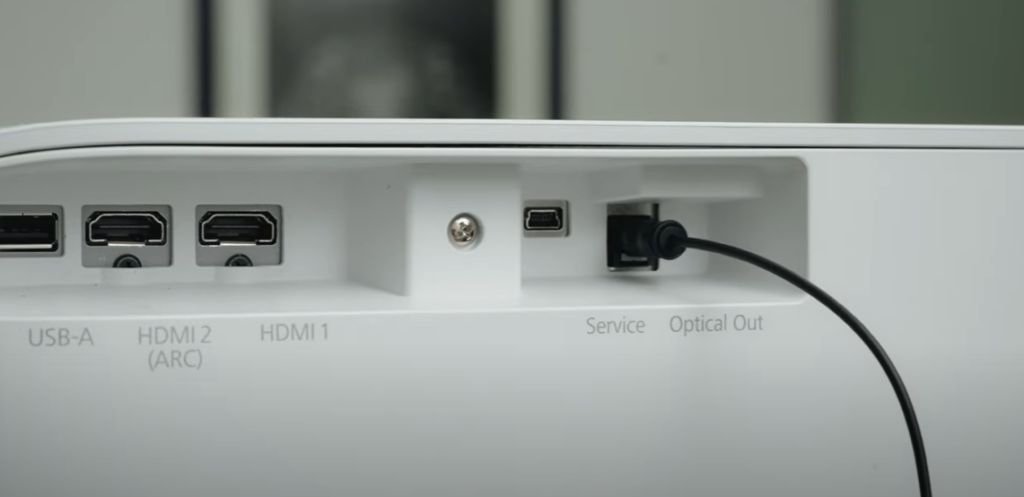
Connecting with S-Video Cables
S-Video cables are another option for connecting audio and video devices. To use them, follow these steps:
- Determine the outputs and inputs on both devices.
- Insert the 4-pin S-Video cable into the “S-Video Out” port on your source device.
- Connect the other end to the “S-Video In” port on your display device.
- Use RCA cables to connect the audio outputs from your source device to the corresponding inputs on your display device, if necessary.
- Turn on both devices and select the appropriate input source on your display device.
- You should now be able to see and hear the content from your source device on your display device.
Connecting with Aux Cables
Aux cables, also known as 3.5mm audio cables, are commonly used to connect devices like smartphones or MP3 players to speakers or car stereos. To use them, follow these steps:
- Locate the headphone jack on your source device and the “Audio In” port on your display device.
- Take one end of the aux cable and insert it into the headphone jack on your source device.
- Connect the other end to the “Audio In” port on your display device.
- Turn on both devices and adjust the volume as needed.
- You should now be able to hear audio from your source device through your display device.
Connecting via Bluetooth
Bluetooth is a wireless technology that allows devices to connect and transfer data without the use of cables. To connect via Bluetooth, follow these steps:
- Make sure both devices have Bluetooth capabilities and are turned on.
- On your source device, go to the Bluetooth settings and turn on pairing mode.
- On your display device, go to the Bluetooth settings and search for available devices.
- Select your source device from the list and pair the devices together.
- Once connected, you can stream audio or transfer files between the two devices wirelessly.
How to choose a soundbar for a projector?
When it comes to setting up a home theater system, there are many components to consider. One important aspect that often gets overlooked is the soundbar. While projectors offer a larger and more impressive viewing experience, they typically don’t have the best built-in speakers. This is where a soundbar comes in.
A soundbar is a type of speaker that sits below or in front of your TV or projector screen. It provides high-quality sound that enhances your viewing experience. But with so many options available, how do you choose the right soundbar for your projector? Here are a few key factors to consider:
Speaker Compatibility
First and foremost, you need to make sure that the soundbar is compatible with your projector. This means checking the connection options and ensuring that they match your projector’s output. For example, if your projector has an HDMI ARC (Audio Return Channel) port, make sure the soundbar also has one.
Sound Quality
The whole point of getting a soundbar is to improve the audio quality when watching movies or TV shows. So it’s important to choose a soundbar that delivers superior sound performance. Look for features like Dolby Digital or DTS audio technology, which provide a more immersive and dynamic sound experience.
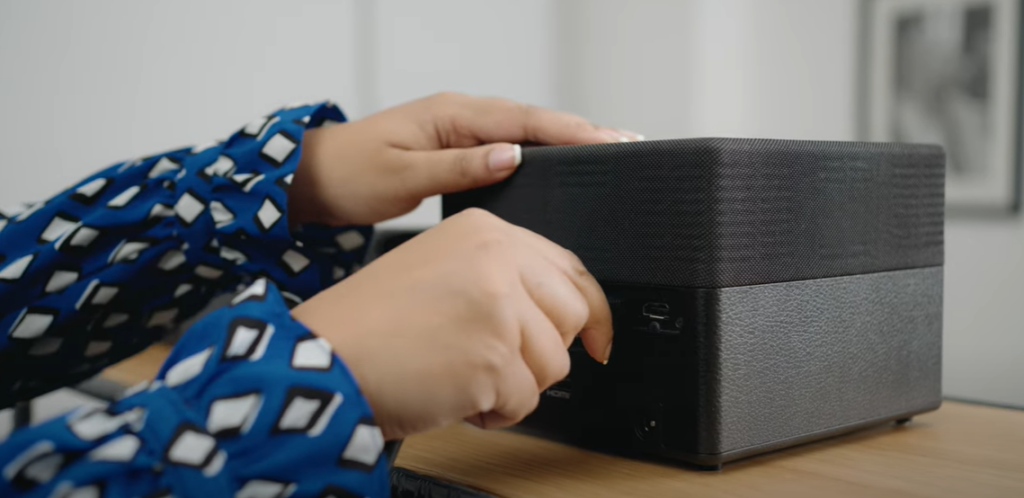
Size and Placement
When choosing a soundbar, consider the size of your projector screen. You want to make sure that the soundbar isn’t too large or small in comparison. Additionally, pay attention to where you plan on placing the soundbar. Some models can be mounted on the wall, while others are designed to sit below or in front of the screen.
Wireless Connectivity
Wireless connectivity is another important factor to consider when choosing a soundbar. This allows you to easily connect your smartphone or other devices and play music or podcasts through the soundbar. It also eliminates the need for extra cords and clutter around your projector setup [3].
FAQ
How do I connect my soundbar to my projector?
Connecting your soundbar to your projector is a simple process that can greatly enhance your viewing experience. To do it, first, make sure that your soundbar and projector are both turned off. Then, take an HDMI cable and connect one end to the HDMI OUT port on your soundbar and the other end to the HDMI IN port on your projector. Once connected, turn on both devices and select the correct input source on your soundbar using its remote control. Your soundbar should now be successfully connected to your projector and you can enjoy a better sound quality while watching movies or TV shows.
What are the advantages of using a soundbar?
There are several advantages to using a soundbar as opposed to traditional speakers or the built-in speakers on your TV. First and foremost, soundbars provide better audio quality with clearer dialogue, deeper bass, and more immersive surround sound. They are also more compact and take up less space than a full set of speakers, making them ideal for smaller rooms or apartments. Additionally, most soundbars come with built-in Bluetooth connectivity, allowing you to easily stream music from your phone or other devices. Some models even have voice control capabilities and can be integrated into a smart home system.
How do I connect my Vizio soundbar to my Epson projector?
To connect your Vizio soundbar to your Epson projector, first, make sure both the soundbar and projector are turned off. Then, using an HDMI cable, connect one end to the HDMI OUT port on your soundbar and the other end to the HDMI IN port on your projector. Once connected, turn on both devices and select the correct input source on your soundbar using its remote control. Your Vizio soundbar should now be successfully connected to your Epson projector and you can enjoy high-quality audio while watching your favorite content. If you encounter any issues, refer to the user manual for further instructions or contact customer support for assistance.
Can I use a soundbar with any projector?
In most cases, yes, you can use a soundbar with any projector as long as it has an HDMI port and supports audio output. However, it is always best to check the specifications of your projector before purchasing a soundbar to ensure compatibility. Some projectors may have limited audio capabilities or require additional equipment for audio output. Additionally, some soundbars may not be compatible with certain projector models, so it’s important to do your research beforehand. If you’re unsure, contact customer support for both the soundbar and projector for further clarification.
Useful Video: 7 Ways to Connect a Projector to Speakers
Conclusion Paragraph
Connecting the Vizio soundbar to the projector is not difficult. All you need is the appropriate cables and a little bit of patience to troubleshoot any potential issues that may arise. You can easily enhance your home theater experience by using these two devices together. With high-quality sound coming from the Vizio soundbar and crystal-clear images from the projector, you can enjoy your favorite movies or TV shows like never before.
References:
- https://www.vizio.com/en/blogs/2022/jan/what-is-a-sound-bar-and-do-i-need-one-
- https://thehometheaterdiy.com/how-to-connect-a-soundbar-to-a-projector/
- https://www.soundbarmag.com/best-soundbar-for-projector/








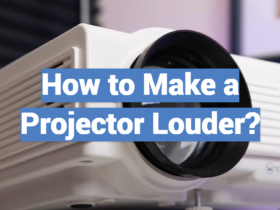

Leave a Review